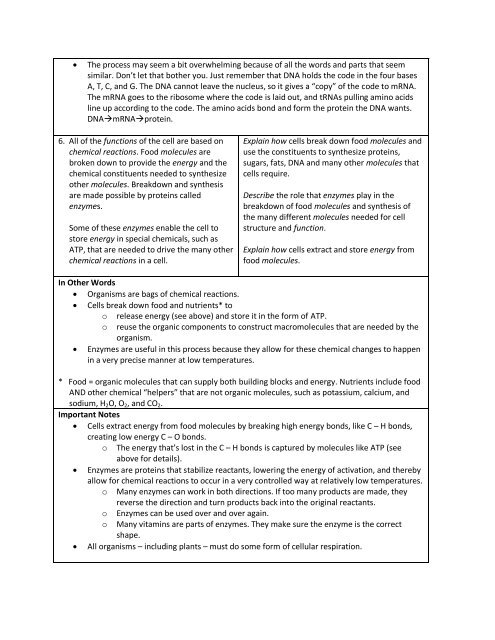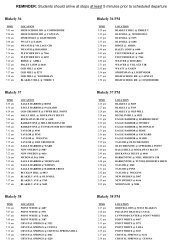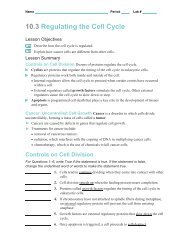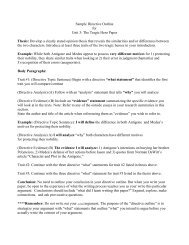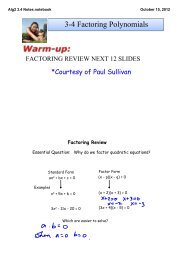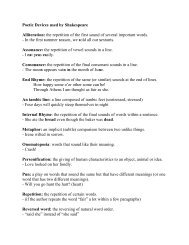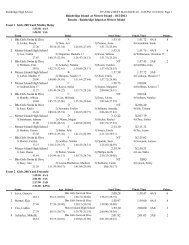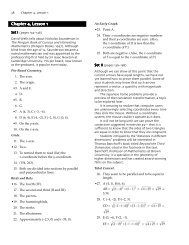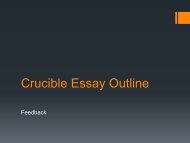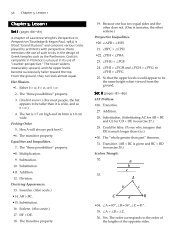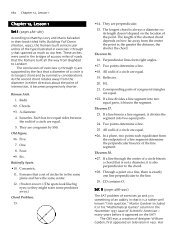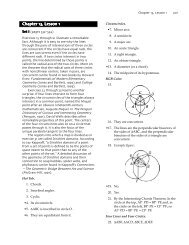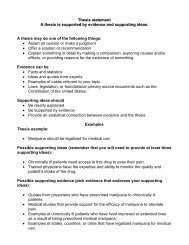Biology EOC Study Guide: Part 2, Cell Biology Content Standards ...
Biology EOC Study Guide: Part 2, Cell Biology Content Standards ...
Biology EOC Study Guide: Part 2, Cell Biology Content Standards ...
Create successful ePaper yourself
Turn your PDF publications into a flip-book with our unique Google optimized e-Paper software.
The process may seem a bit overwhelming because of all the words and parts that seem<br />
similar. Don’t let that bother you. Just remember that DNA holds the code in the four bases<br />
A, T, C, and G. The DNA cannot leave the nucleus, so it gives a “copy” of the code to mRNA.<br />
The mRNA goes to the ribosome where the code is laid out, and tRNAs pulling amino acids<br />
line up according to the code. The amino acids bond and form the protein the DNA wants.<br />
DNAmRNAprotein.<br />
6. All of the functions of the cell are based on<br />
chemical reactions. Food molecules are<br />
broken down to provide the energy and the<br />
chemical constituents needed to synthesize<br />
other molecules. Breakdown and synthesis<br />
are made possible by proteins called<br />
enzymes.<br />
Some of these enzymes enable the cell to<br />
store energy in special chemicals, such as<br />
ATP, that are needed to drive the many other<br />
chemical reactions in a cell.<br />
Explain how cells break down food molecules and<br />
use the constituents to synthesize proteins,<br />
sugars, fats, DNA and many other molecules that<br />
cells require.<br />
Describe the role that enzymes play in the<br />
breakdown of food molecules and synthesis of<br />
the many different molecules needed for cell<br />
structure and function.<br />
Explain how cells extract and store energy from<br />
food molecules.<br />
In Other Words<br />
Organisms are bags of chemical reactions.<br />
<strong>Cell</strong>s break down food and nutrients* to<br />
o release energy (see above) and store it in the form of ATP.<br />
o reuse the organic components to construct macromolecules that are needed by the<br />
organism.<br />
Enzymes are useful in this process because they allow for these chemical changes to happen<br />
in a very precise manner at low temperatures.<br />
* Food = organic molecules that can supply both building blocks and energy. Nutrients include food<br />
AND other chemical “helpers” that are not organic molecules, such as potassium, calcium, and<br />
sodium, H 2 O, O 2 , and CO 2 .<br />
Important Notes<br />
<strong>Cell</strong>s extract energy from food molecules by breaking high energy bonds, like C – H bonds,<br />
creating low energy C – O bonds.<br />
o The energy that’s lost in the C – H bonds is captured by molecules like ATP (see<br />
above for details).<br />
Enzymes are proteins that stabilize reactants, lowering the energy of activation, and thereby<br />
allow for chemical reactions to occur in a very controlled way at relatively low temperatures.<br />
o Many enzymes can work in both directions. If too many products are made, they<br />
reverse the direction and turn products back into the original reactants.<br />
o Enzymes can be used over and over again.<br />
o Many vitamins are parts of enzymes. They make sure the enzyme is the correct<br />
shape.<br />
All organisms – including plants – must do some form of cellular respiration.


